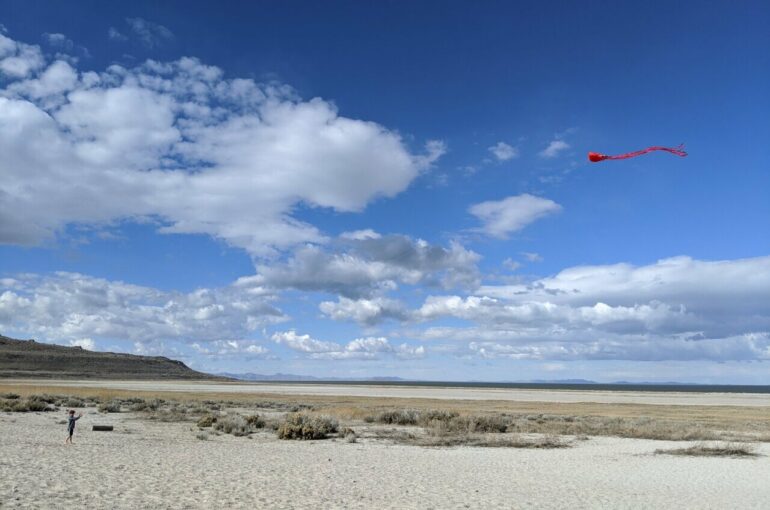Inland seas around the world are drying up due to increasing human water use and accelerating climate change, and their desiccation is releasing harmful dust that pollutes the surrounding areas during acute dust storms. Using the Great Salt Lake in Utah as a case study, researchers show that dust exposure was highest among Pacific Islanders and Hispanic people and lower in white people compared to all other racial/ethnic groups, and higher for individuals without a high school diploma.
Restoring the lake would benefit everyone in the vicinity by reducing dust exposure, and it would also decrease the disparities in exposure among different racial/ethnic and socioeconomic groups. These results are reported June 21 in the journal One Earth.
“People here in Utah are concerned about the lake for a variety of reasons—the ski industry, the brine shrimp, the migratory birds, recreation—and this study adds environmental justice and the equity implications of the drying lake to the conversation,” says first author and sociologist Sara Grineski of the University of Utah.
“If we can raise the levels of the lake via some coordinated policy responses, we can reduce our exposure to dust, which is good for everyone’s health, and we can also reduce the disparity between groups.”
The Great Salt Lake has been steadily drying since the mid-1980s, exposing its dry lakebed to atmospheric weathering and wind. Previous studies have shown that dust emissions from drying salt lakes produce fine particulate matter (PM2.5), which is associated with numerous health effects and is the leading environmental cause of human mortality worldwide.
“We know that the dust from these drying lakes is very unhealthy for us, so the question becomes, what does that mean in terms of people’s exposure to the dust, and what does it mean in terms of inequalities in exposure to that dust?” says Grineski. “Are some people more likely to have to suffer the consequences to a greater degree?”
To answer this question, Grineski teamed up with a multidisciplinary group including atmospheric scientists, geographers, and biologists. They started by using a model to investigate how dust pollution would change if the lake became even dryer, or if its levels rose to a healthy level.
The model simulated how much dust would be created by erosion under different lake-level scenarios and how wind would distribute this dust in three counties surrounding the Great Salt Lake. Then, the team combined the model’s outputs with demographic data from the 2020 U.S. Decennial Census and American Community Survey to examine whether the severity of dust exposure is associated with racial/ethnic groups or socioeconomic status.
During a typical dust storm, the team found that at the lake’s current level, people in the Great Salt Valley are exposed to 26 μg/m3 of dust PM2.5 on average, which is higher than the World Health Organization’s threshold of 15 μg/m3 (though lower than the less stringent U.S. National Ambient Air Quality Standards threshold of 35 μg/m3). If the lake were to dry up completely, average exposure during dust storms would increase to 32 μg/m3, but restoring the lake to a healthy level would decrease the average exposure to 24 μg/m3.
They also showed that some groups within the population are exposed to disproportionate levels of dust. Exposure was highest in Pacific Islanders and Hispanic people, and higher in people without a high school diploma (one metric of socioeconomic status), though there was no association between the risk of dust exposure and income level or home ownership.
Raising the lake’s level would decrease the disparities between groups, thus helping to alleviate one form of environmental injustice within the region, though Grineski notes that the valley is home to other social disparities in pollution exposure.
“If the lake’s level rises, the dust drops, and the disparity in exposure narrows for race/ethnicity and education,” says Grineski.
In the future, the team would like to investigate how potential future changes to the region’s population size and shape might influence who is most exposed to dust from the lake. Ultimately, they hope their results will help guide local policymakers to prioritize refilling the Great Salt Lake.
“If we were to enact policy and conservation measures to raise the lake, we would benefit not only in terms of decreased dust, but in terms of less dramatic disparities between who is breathing in more of this dust,” says Grineski. “It’s important to consider the environmental justice implications of different choices that we might make in the policy arena when we think about different strategies for adaptation and mitigation to climate change.”
More information:
Harmful dust from drying lakes: Preserving Great Salt Lake (USA) water levels decreases ambient dust and racial disparities in population exposure, One Earth (2024). DOI: 10.1016/j.oneear.2024.05.006. www.cell.com/one-earth/fulltex … 2590-3322(24)00249-5
Citation:
Restoring the Great Salt Lake would support environmental justice as well as have ecological benefits, researchers say (2024, June 21)



